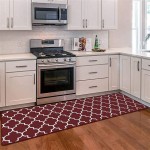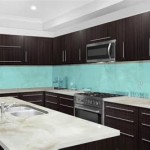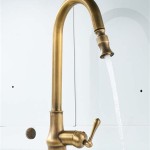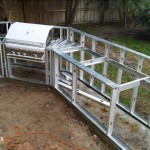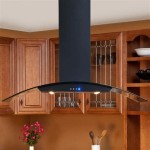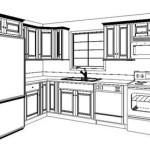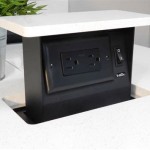DIY Kitchen Renovations on a Budget
Embarking on a kitchen renovation can be a daunting prospect, often associated with substantial financial investment and extensive disruption to daily life. However, achieving a refreshed and functional kitchen space does not necessarily require a bank-breaking budget. DIY (Do-It-Yourself) kitchen renovations offer a viable alternative, empowering homeowners to transform their kitchens incrementally, controlling costs, and injecting personal style into the heart of the home.
The key to a successful and budget-friendly DIY kitchen renovation lies in meticulous planning and a strategic approach. Prioritizing essential upgrades, repurposing existing elements, and embracing resourceful material sourcing are crucial elements in keeping costs manageable. Furthermore, understanding personal skill levels and limitations is paramount; knowing when to engage professional assistance for specific tasks can prevent costly errors and ensure safety.
Strategic Planning and Prioritization
Before lifting the first tool or purchasing any materials, a comprehensive plan is essential. This involves a detailed assessment of the existing kitchen layout, identifying areas that require improvement, and establishing clear objectives for the renovation. A critical step involves creating a realistic budget and allocating funds for various aspects of the project, such as materials, tools, and potential professional services.
Prioritization is key to staying within budget. Instead of attempting a complete overhaul, focus on the most impactful changes. For example, replacing outdated cabinet hardware, painting existing cabinets, or upgrading the countertop can dramatically improve the kitchen's aesthetic without incurring significant expenses. Distinguishing between needs and wants is crucial in this phase; a high-end appliance might be appealing, but a more affordable option that meets functional requirements can free up funds for other essential upgrades.
Accurate measurements are also essential. Carefully measure the kitchen space, including walls, cabinets, and appliances. These measurements will be crucial when purchasing materials, ensuring that everything fits properly and minimizing waste. Consider creating a scaled drawing or using online kitchen design tools to visualize the proposed changes and identify potential challenges.
Repurposing and Refurbishing Existing Elements
One of the most effective ways to save money on a DIY kitchen renovation is to repurpose and refurbish existing elements. Instead of replacing cabinets, consider painting or refinishing them. Updating the cabinet hardware with new knobs and pulls can instantly transform the look of the cabinets without the expense of purchasing new ones. Thorough cleaning and minor repairs, such as filling in scratches or dents, can significantly improve the appearance of existing cabinets.
Existing countertops can also be revitalized. If the countertops are made of solid surface materials, they can often be sanded and polished to remove scratches and stains. For laminate countertops, consider refinishing options or applying a decorative film. In some cases, replacing the countertop edge banding can provide a refreshed look at a minimal cost. Consider repurposing salvaged materials for countertops, backsplashes, or even decorative elements in the kitchen. Reclaimed wood, for example, can add character and warmth to the space.
Think creatively about how existing appliances can be incorporated into the new design. If the appliances are still functional and in good condition, there is no need to replace them. A fresh coat of paint or a new appliance handle can provide a refreshed look. Consider rearranging the appliances to improve the kitchen’s workflow and functionality.
Resourceful Material Sourcing and Cost-Effective Alternatives
Sourcing materials wisely is crucial for staying within budget. Explore options beyond traditional retail outlets. Check local salvage yards, architectural salvage stores, and online marketplaces for discounted or reclaimed materials. These sources often offer unique and characterful options at significantly lower prices than new materials.
Consider cost-effective alternatives to expensive materials. For example, instead of granite countertops, explore laminate or butcher block options. Laminate countertops have significantly improved in quality and design, offering a wide range of styles and colors at a fraction of the cost of granite. Butcher block countertops can add warmth and character to the kitchen while being relatively affordable, especially if purchased unfinished and sealed by the homeowner.
For flooring, consider vinyl flooring, which is durable, water-resistant, and relatively inexpensive. Vinyl flooring is available in a wide range of styles, including options that mimic wood, tile, and stone. Alternatively, refinishing existing hardwood floors can be a cost-effective way to update the kitchen's look. For backsplashes, consider using ceramic tile, which is a budget-friendly option that is available in a wide variety of colors, patterns, and sizes. Alternatively, consider using paintable beadboard or peel-and-stick tiles for a more unconventional and budget-conscious backsplash.
Lighting is an important aspect of a kitchen renovation, and energy-efficient LED lighting is a cost-effective option. LED lights are long-lasting and consume significantly less energy than traditional incandescent bulbs, resulting in lower energy bills. Consider installing under-cabinet lighting to illuminate countertops and improve visibility. Consider using pendant lights over the kitchen island or breakfast bar to add a touch of style and functionality.
When purchasing materials, take advantage of sales, discounts, and coupons. Many home improvement stores offer promotional discounts throughout the year. Sign up for email newsletters and follow social media accounts to stay informed about upcoming sales. Compare prices from different retailers to ensure that you are getting the best deal. Consider purchasing materials in bulk to take advantage of quantity discounts. Carefully estimate the amount of materials needed to minimize waste and avoid unnecessary expenses.
Consider using reclaimed or recycled materials whenever possible. Reclaimed wood can be used for shelving, countertops, or decorative elements. Recycled glass tiles can be used for backsplashes. Using reclaimed or recycled materials not only saves money but also reduces the environmental impact of the renovation.
DIY Projects: Cabinet Painting and Hardware Upgrades
One of the most impactful and cost-effective DIY projects in a kitchen renovation is painting or refinishing existing cabinets. This can dramatically transform the look of the kitchen without the expense of replacing the cabinets. Begin by thoroughly cleaning the cabinets to remove any grease, dirt, or grime. Sand the cabinets lightly to create a smooth surface for the paint to adhere to. Apply a primer coat and then two coats of high-quality paint, allowing each coat to dry completely before applying the next. Consider using a paint sprayer for a professional-looking finish.
Replacing the cabinet hardware is another simple and affordable way to update the look of the cabinets. Choose knobs and pulls that complement the style of the kitchen. Consider using different finishes, such as brushed nickel, oil-rubbed bronze, or stainless steel. When replacing the hardware, be sure to measure the existing holes to ensure that the new hardware will fit properly. Consider using a template to drill new holes if necessary.
Consider adding decorative elements to the cabinets to enhance their appearance. Adding trim molding to the cabinet doors can add a touch of elegance. Consider using glass inserts in some of the cabinet doors to create a display area. Adding under-cabinet lighting can illuminate the countertops and improve visibility. Consider using decorative shelf paper inside the cabinets to add a pop of color and personality.
When painting or refinishing cabinets, be sure to work in a well-ventilated area. Wear a mask and gloves to protect yourself from fumes and chemicals. Use drop cloths to protect the surrounding surfaces from paint splatters. Take your time and pay attention to detail to achieve a professional-looking finish. Patience and attention to detail are crucial for a successful cabinet painting project.
DIY Projects: Backsplash Installation and Countertop Updates
Installing a new backsplash is another manageable DIY project that can significantly enhance the look of the kitchen. Choose a backsplash material that complements the style of the kitchen and fits within the budget. Ceramic tile is a popular and affordable option. Peel-and-stick tiles offer an even easier installation method, suitable for novice DIYers. Properly prepare the wall surface by cleaning and leveling it. Apply adhesive according to the manufacturer's instructions and carefully position the tiles. Grout the tiles and clean up any excess grout. Taking careful measurements and precise cuts are essential for a professional-looking backsplash installation.
While completely replacing a countertop may be best left to professionals, some updates can be done DIY-style. For laminate countertops, consider applying a decorative film or refinishing the surface with a specialized countertop paint. For butcher block countertops, applying a sealant or stain can protect the wood and enhance its beauty. Replacing the countertop edge banding can also provide a refreshed look at a minimal cost. Cleaning and polishing existing countertops can restore their shine and improve their appearance.
When installing a backsplash, be sure to wear safety glasses to protect your eyes from debris. Use a tile cutter or wet saw to cut the tiles to the appropriate size. Use a level to ensure that the tiles are installed straight and evenly. Allow the adhesive to dry completely before grouting the tiles. Apply the grout evenly and wipe away any excess grout with a damp sponge. Allow the grout to dry completely before sealing it.
When updating countertops, be sure to follow the manufacturer's instructions for the specific product you are using. Wear gloves and a mask to protect yourself from chemicals. Work in a well-ventilated area. Allow the products to dry completely before using the countertop.
Knowing When to Seek Professional Assistance
While DIY kitchen renovations offer significant cost savings, it is crucial to recognize personal limitations and when professional assistance is necessary. Certain tasks, such as electrical work, plumbing, and structural modifications, require specialized knowledge and expertise. Attempting these tasks without proper training can be dangerous and can result in costly errors or even serious injury. Engaging licensed and insured professionals for these critical tasks ensures safety and compliance with building codes.
Consider consulting with a professional for tasks that require specialized tools or equipment. For example, if you are installing new countertops that require precise cuts and installation, it may be worth hiring a professional to ensure that the job is done correctly. If you are unsure about any aspect of the renovation, don't hesitate to seek professional advice. Consulting with a designer or contractor can provide valuable insights and help you avoid costly mistakes.
When hiring professionals, be sure to get multiple quotes and check their references. Ask for proof of insurance and licensing. Discuss the scope of the work in detail and get a written contract that outlines the terms and conditions of the agreement. Communicate clearly with the professionals throughout the renovation process to ensure that the project is completed to your satisfaction.
Ultimately, a successful DIY kitchen renovation on a budget requires careful planning, strategic prioritization, resourceful material sourcing, and a realistic assessment of personal skills. By embracing creative solutions, repurposing existing elements, and knowing when to seek professional assistance, homeowners can transform their kitchens into beautiful and functional spaces without breaking the bank.

Diy Budget Kitchen Renovation Our Gorgeous Reveal Dwell Beautiful

Before And After My Budget Kitchen Remodel Toolbox Divas

Diy Kitchen Makeover On A Budget Modern Farmhouse Style
Our Diy Kitchen Remodel Before And After Tackling A Farmhouse Makeover On Budget Part 1 Joyfully Treasured

Before And After Diy Kitchen Renovation Lemon Thistle

Kitchen Remodel On A Budget Fresh Squeezed Life

Diy Budget Kitchen Renovation Our Gorgeous Reveal Dwell Beautiful

Budget Under 100 Easy Diy Makeover Kitchen Organization Home Room Make Over Decorate With Me

Budget Friendly Diy Bungalow Kitchen Makeover With Painted Cabinets I

100 Diy Kitchen Makeover New On A Budget Home Renovations Before And After
Related Posts

